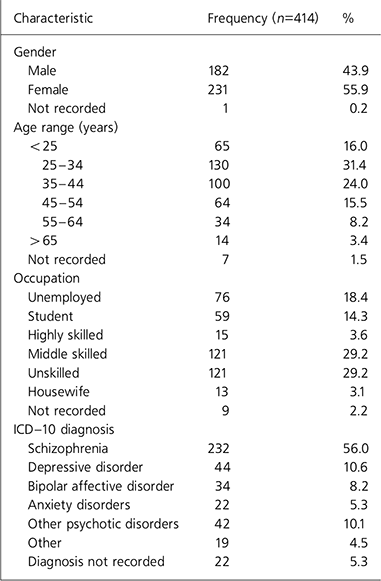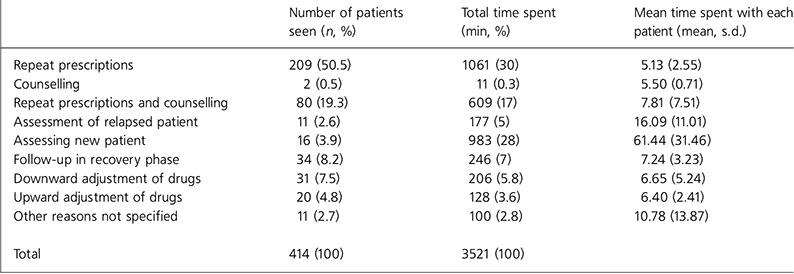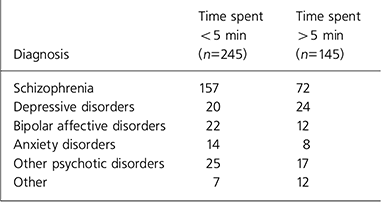The psychiatric out-patient clinic is an important component of mental health services for patients who are less severely ill. This is especially the case in developing countries, where the out-patient clinic is the only link between the community and the psychiatric hospital, and the only avenue for continuity of care after discharge from hospital. Apart from the fact that community mental health services are absent or limited in developing countries, psychiatrists and other mental health workers are few (Reference Saraceno and SaxenaSaraceno & Saxena, 2002), and should use their time optimally and creatively. This study examines the reasons for consultation and the time allotted to these reasons in the psychiatry out-patient clinic within a university teaching hospital. The aim is to identify activities that can be modified to improve the quality of services rendered.
Method
Setting
The study was carried out in the psychiatric out-patient clinic at the University College Hospital, Ibadan, in the south-western part of Nigeria. Although it principally serves Ibadan and its environs, with a population of greater than 3 million, its catchment area is not well defined.
This study was carried out over a period of one month. Two psychiatric out-patient clinics were run each week, on Monday and Friday afternoons. The patients arrived at about noon to get their case files retrieved from the records department. The doctors started consultations at 2 p.m. All patients who visited were attended to and the clinic continued until all patients were seen. No appointment records are kept and so the number of patients that will be seen in the clinic on each day is not known. The amount of time each doctor spends with each patient is not regulated and so there is no time limit on how long each patient stays with a doctor. A consultant either sees all new patients or, if seen by a resident, the case is discussed with a consultant. At the time of the study, one consultant and four residents attended each clinic.
Study design
Before the study commenced, O.O. trained all the doctors on the method of filling in the form. Each doctor was asked to complete the data for every patient immediately after they were seen. The form was a simple sheet where information for 20 patients could be recorded. Information documented was age, gender, occupation, reason for consultation and time spent. At the top of the form, nine probable reasons why the patients attended were written and the corresponding number codes were inserted, making it easy to select a reason for consultation. The nine reasons listed were as follows: patient for repeat prescription; patient for counselling; patient for repeat prescription and counselling; relapse of illness; new patient for assessment; patient recovering from illness; downward review of medication; upward review of medication; and other. These alternatives were derived from observations at previous clinics and discussions with the doctors. The practice in the clinic is to use the ICD-10 diagnostic criteria (World Health Organization, 1992) to arrive at a diagnosis.
Statistical analysis
Data were analysed with the Statistical Package for the Social Sciences Version 10. Differences between groups were tested for statistical significance by using χ2-tests for categorical variables, applying Yates' correction where necessary.
Results
All the patients who attended clinic during the period of study were recruited into the study. A total of 414 patients were seen in the seven clinic days, which is an average of 59 (s.d.=4.67) patients each clinic day.
Table 1 reveals their socio-demographic characteristics and psychiatric diagnosis. The consulting doctors, as reflected in the table, did not record some of the information. When the patients were divided into two groups based on their age (<25 years and >25 years) it was found that the females were significantly older than the males (χ2=11.579; d.f.=1; P=0.001). The mean age for females was 40.19 (s.d.=13.27) and that for males was 34.07 (s.d.=12.46). Most of the patients (56%) who attended the clinic during this period had a diagnosis of schizophrenia. The ‘other’ category included patients with somatoform disorders, organic mental disorders and epilepsy.
Table 1. Demographic characteristics and psychiatric diagnosis

| Characteristic | Frequency (n=414) | % |
|---|---|---|
| Gender | ||
| Male | 182 | 43.9 |
| Female | 231 | 55.9 |
| Not recorded | 1 | 0.2 |
| Age range (years) | ||
| <25 | 65 | 16.0 |
| 25-34 | 130 | 31.4 |
| 35-44 | 100 | 24.0 |
| 45-54 | 64 | 15.5 |
| 55-64 | 34 | 8.2 |
| >65 | 14 | 3.4 |
| Not recorded | 7 | 1.5 |
| Occupation | ||
| Unemployed | 76 | 18.4 |
| Student | 59 | 14.3 |
| Highly skilled | 15 | 3.6 |
| Middle skilled | 121 | 29.2 |
| Unskilled | 121 | 29.2 |
| Housewife | 13 | 3.1 |
| Not recorded | 9 | 2.2 |
| ICD-10 diagnosis | ||
| Schizophrenia | 232 | 56.0 |
| Depressive disorder | 44 | 10.6 |
| Bipolar affective disorder | 34 | 8.2 |
| Anxiety disorders | 22 | 5.3 |
| Other psychotic disorders | 42 | 10.1 |
| Other | 19 | 4.5 |
| Diagnosis not recorded | 22 | 5.3 |
Reasons for consultation and time spent
Table 2 shows the various reasons for consultation and the time spent for each of the reasons. Half of all the patients came for repeat prescriptions and another one-fifth came for both repeat prescriptions and counselling. Although the mean times spent on these two activities were 5.13 (s.d.=2.5) and 7.81 (s.d.=7.51) minutes respectively, the large number of these patients meant that 47% of clinic time was spent on these activities.
Table 2. Reasons for consultation and time spent for the various reasons in the clinic (n=414)

| Number of patients seen (n, %) | Total time spent (min, %) | Mean time spent with each patient (mean, s.d.) | |
|---|---|---|---|
| Repeat prescriptions | 209 (50.5) | 1061 (30) | 5.13 (2.55) |
| Counselling | 2 (0.5) | 11 (0.3) | 5.50 (0.71) |
| Repeat prescriptions and counselling | 80 (19.3) | 609 (17) | 7.81 (7.51) |
| Assessment of relapsed patient | 11 (2.6) | 177 (5) | 16.09 (11.01) |
| Assessing new patient | 16 (3.9) | 983 (28) | 61.44 (31.46) |
| Follow-up in recovery phase | 34 (8.2) | 246 (7) | 7.24 (3.23) |
| Downward adjustment of drugs | 31 (7.5) | 206 (5.8) | 6.65 (5.24) |
| Upward adjustment of drugs | 20 (4.8) | 128 (3.6) | 6.40 (2.41) |
| Other reasons not specified | 11 (2.7) | 100 (2.8) | 10.78 (13.87) |
| Total | 414 (100) | 3521 (100) |
Psychiatric diagnosis and time spent
The relationship between the diagnosis and time spent is illustrated in Table 3. Patients with depression and the ‘other’ category spent more time with the doctors than those with the other diagnoses (χ2=14.653; d.f.=5; P=0.012).
Table 3. Psychiatric diagnosis and time spent on consultation

| Diagnosis | Time spent <5 min (n=245) | Time spent >5 min (n=145) |
|---|---|---|
| Schizophrenia | 157 | 72 |
| Depressive disorders | 20 | 24 |
| Bipolar affective disorders | 22 | 12 |
| Anxiety disorders | 14 | 8 |
| Other psychotic disorders | 25 | 17 |
| Other | 7 | 12 |
Discussion
It is significant to note that almost three-quarters of the patients came for repeat prescriptions. In some instances, they needed some counselling. It may be argued that it does not really matter that highly-skilled mental health staff spend time in the out-patient clinic writing repeat prescriptions because the time spent on each patient for this activity was significantly shorter than that spent on other activities, such as assessing new and relapsed patients. However, these patients consumed almost half of clinic consultation time.
In a country where the psychiatrist:patient ratio is less than 1 per million population (Reference OkashaOkasha, 2002) and where 70% of the population have no access to modern mental health facilities (Federal Ministry of Health, 1991), is it really cost-effective to have highly-skilled mental health staff spending so much time with such activities? Many of these patients would have travelled several kilometres to the clinic and would have waited sometimes for up to 4 or 5 h just to pick up a repeat prescription. The mean time spent for writing each repeat prescription was just 5.13 minutes and when counselling was added, the mean time was 7.81 minutes. Spending an additional 2 minutes for counselling appears rather short. Would the patients have had adequate time to express themselves or ask questions?
The time spent on assessing new patients appears adequate, because the normal practice is for a detailed history and mental status examination to be carried out, followed by a physical examination. However, there is a wide variation in the time spent on the activity and this important initial assessment may require standardisation.
Patients with depression and those in the ‘other’ category spent more time for consultation. These patients were possibly more demanding of the doctors' time or received more sympathy owing to their mental state. Studies show that the less time doctors spend with patients, the less satisfied the patients are with the consultation and the less likely doctors are to identify problems (Reference Morrell, Evans and MorrisMorrell et al, 1986). Would these patients be better off in some other health facility where their holistic needs could be addressed? Or would relieving the doctors of the burden of writing repeat prescriptions make more time available for them to spend with these ‘needy’ patients?
Policy-makers must be made aware of the inefficiencies in clinic service provision so that the meagre funds available for health care services can be utilised optimally. Farooq & Minhas (Reference Farooq and Minhas2001) have stressed that community psychiatry as practised in the developed world context is not the answer to the mental health problem in developing countries but ‘primary care psychiatry’ is, as proposed by the World Health Organization (1975). In several developing countries there are small pockets of models integrating mental health into primary health care but these models are never implemented on a national scale. Jacob (Reference Jacob2001) gave many reasons for this, including a lack of professional commitment and political will. Wulsin (Reference Wulsin1996) strongly argues that psychiatric hospitals should boost their relationship with primary health care by having programmes containing clinical, research and educational components. For this to occur there must be a shift in focus and funds.
There are, however, some immediate steps that can be put in place to improve this service. Bellon Saamero et al (Reference Bellon SAAMERO, Molina GUERRERO and Panadero VALLEY1995) found that 50% of interview time in primary care was taken up by bureaucratic and recording activities. They stressed a need for certain organisational changes in consultations, or some kind of bureaucratic-administrative support so that the fraction of interview time dedicated to doctor-patient communication can be increased. In line with this suggestion, some simple measures can be carried out for an immediate improvement in the service delivery within our institution. These could include a sorting exercise carried out before the clinic starts, to find out why patients have come to the clinic. The nurses may assist in the writing out of the repeat prescriptions and a resident doctor could be assigned to check and sign these repeat prescriptions. Time also should be allotted to each activity, thus introducing some structure and allowing work to spread out more evenly. The average times obtained in this study can be used as guidelines to allocate a time for each of these activities.






eLetters
No eLetters have been published for this article.